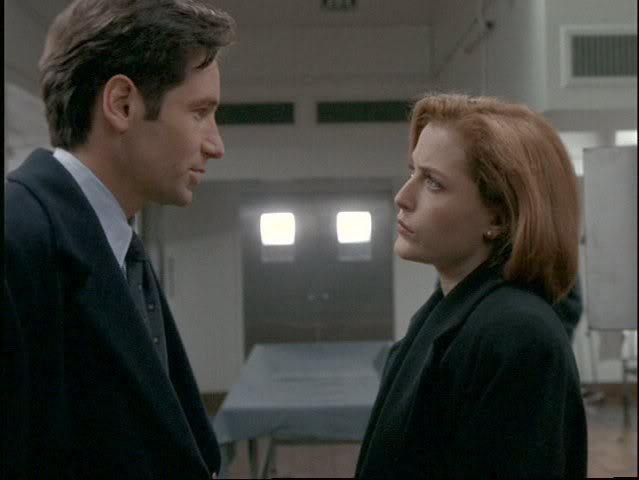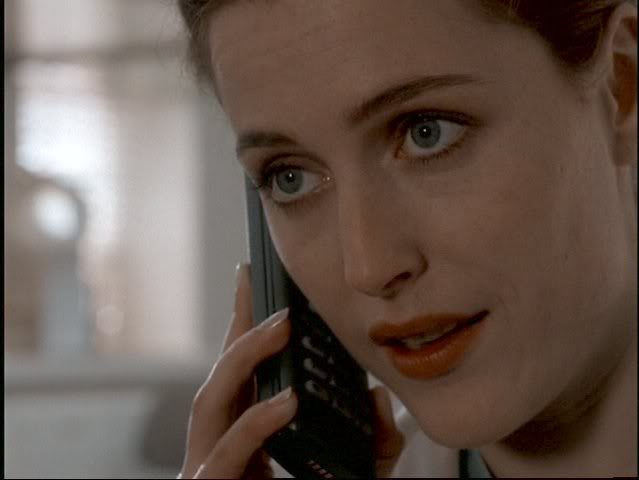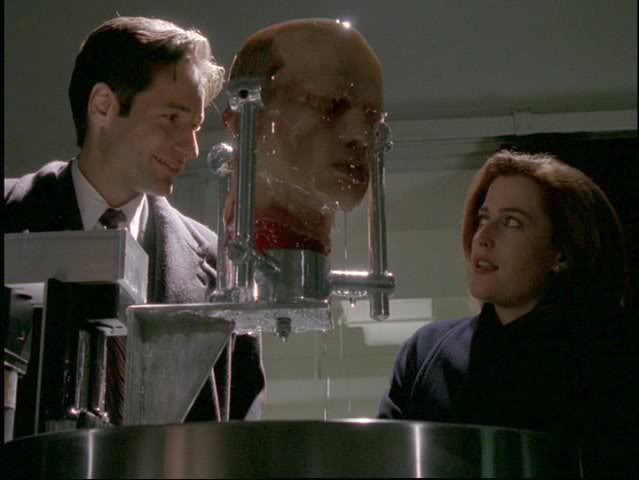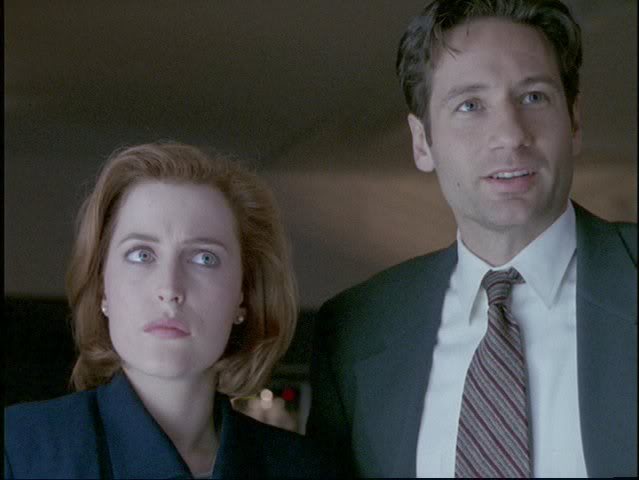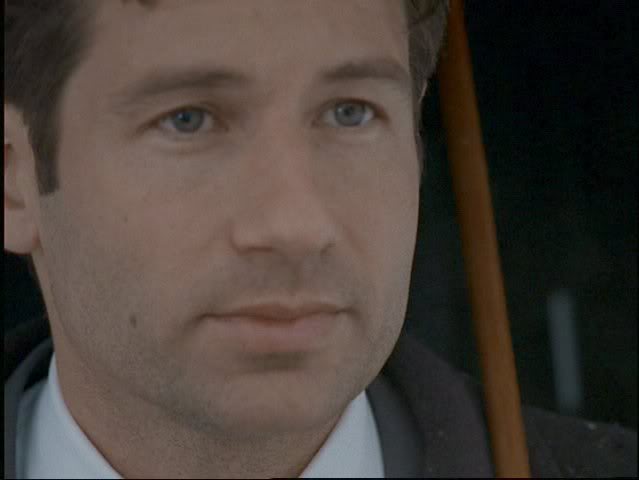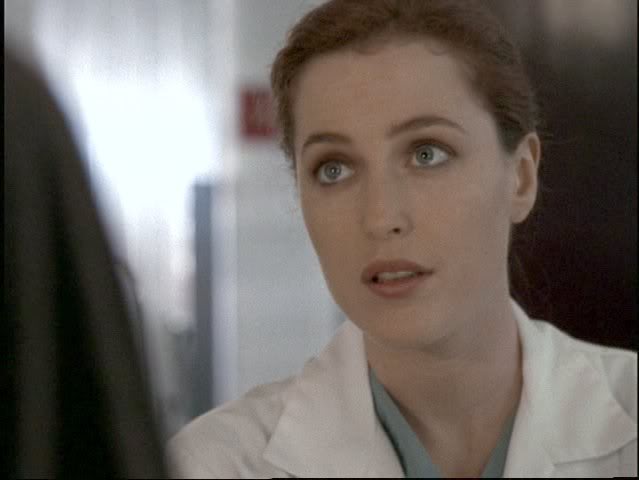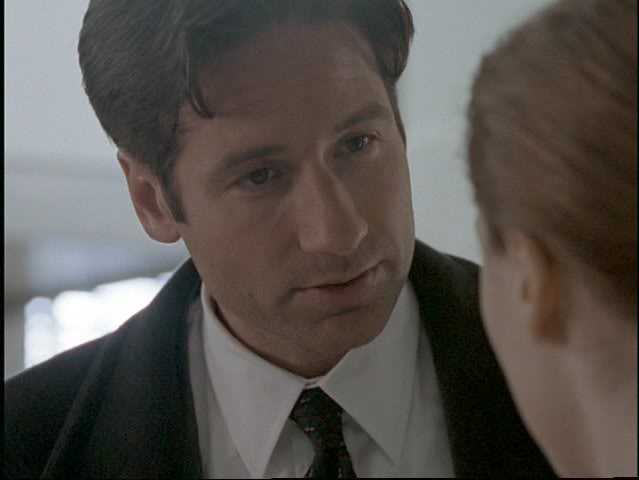CTP Episode of the Day - 11.03.06 - Leonard Betts
Today's Cherished Episode: Leonard Betts (4x14)
Original Air Date: January 26, 1997
Written By: Vince Gillian, John Shiban, and Frank Spotnitz
Directed By: Kim MannersA headless corpse escapes from a hospital morgue. Mulder and Scully investigate; what they find leads them to the jagged dividing line between life and death.
"I'm sorry, but you've got something I need."
Some "Leonard Betts" Tidbits & Musings:
-- The TV broadcast of the Super Bowl is rotated annually between the over-the-air networks that carry NFL football; every couple of years or so, one of them tries to boost the fortunes of one of its fledgling series by scheduling it directly after the championship game. In 1997 the honchos at Fox managed to resist that temptation -- and instead scheduled its highest-rated series for the coveted post-Super Bowl airing. Fox's reward for that strategy? The show drew an audience nearly twice as large as usual. Close to 30 million Americans watched the quintessential -- and pivotal -- X-Files episode "Leonard Betts."
-- "Kaddish" was the 12th episode of the fourth season filmed; and had the season's episodes aired in order, it would have been the episode to air in the twelfth week of the season -- after the Super Bowl on January 26. But it was determined that "Leonard Betts" would be better suited to the larger audience guaranteed by a post-Super Bowl time slot, so "Kaddish" was pushed back almost a month and was the 15th episode of the season aired (after "Never Again" and "Memento Mori").
-- Story editor John Shiban explained why "Leonard Betts" was chosen as the best representation of The X-Files for that cushy time slot: "It was like a good first season-style show. There was humor; there was some Mulder-and-Scully back-and-forth; there were some cool special effects; it was scary -- and there was even some real science behind it."
-- It was also the show in which the producers "gave" Scully cancer: a decision that would seriously affect the course of the rest of the fourth season. From "Leonard Betts" on, every episode -- even if it was designed to take viewers' minds off Scully's condition -- would have to deal with that single factor.
-- "It was an idea that I'd suggested the summer before -- but we'd sort of tabled the discussion," explained coproducer Frank Spotnitz. The idea stayed tabled, he added, until with the fourth season well under way, he and Shiban -- "We're good friends and had worked a lot together in Season 3" -- decided to collaborate on an episode.
-- The seed for "Leonard Betts" had been planted a short time before. John Shiban, Spotnitz explained, had read an article in a New Age-type magazine on the quasi-scientific concept of "edglings": humans who have taken an evolutionary leap past their fellow men, therefore acquiring strange powers and abilities that would be useful in the future but are bizarre and frightening today.
-- "So," added Spotnitz, "together we worked our way through this concept. Well, we thought, what's the greatest threat to us right now? Cancer. And so a great leap forward for evolution would be someone who not only was immune to cancer, but fed on it."
-- It was Shiban who realized that the still-embryonic story line would be the "perfect entree" to Scully's cancer arc. "At that moment," said the story editor, "I realized that we'd better go see Chris. And he was all for it -- he told me that it was the moment he was waiting for."
-- "Actually," said Chris Carter, "I knew this was a great opportunity to tweak the audience -- to get them thinking. But I honestly thought it might pass some people by. That they wouldn't get it. But they got it in a big, big way."
-- "We were afraid people wouldn't pick up on it, to be honest," added John Shiban. "We thought that some of the audience members would get it, some people -- it would go right over their heads. But on the internet the next morning, that evening actually, when the postings started piling up, and everybody was picking up on it, everyone was frantic. 'What's going to happen, Scully's got cancer!' So it worked very nicely. It was a very nice way to do it without shining a light on it."
-- "It made perfect sense that, you know, Scully was abducted by aliens, we think, and these other women were getting cancer who were also abducted so why shouldn't she get cancer as well," added Vince Gilligan.
-- Gilligan, the third member of the "Leonard Betts" writing troika, was credited with fleshing out the character of Leonard himself, making him more of a sympathetic character who killed not out of vengeance or anger, but for survival.
-- "What I liked about this character was that he was not malicious," said John Shiban. "He just couldn't help himself and it made for a dilemma for him. He felt sorry for what he did and that was something different for us."
-- "When I shot 'Leonard Betts' I learned something about directing the X-Files and I've used it ever since that episode of 'Leonard Betts'," said Kim Manners. "I learned that even your villains have got to have a heart."
-- To play this tricky part, the producers chose Paul McCrane, a former teenage actor who had successfully made the transition to adult character roles in projects like Robocop ("I was the guy who wound up in the vat of toxic waste," he said) and the well-received 1996 CBS crime drama Under Suspicion.
-- To turn himself into a thin, bald emergency medical technician, McCrane had to do practically nothing. Playing the rest of the role, though, was a different matter. In preparation for his transformation scenes, he had to spend several hours in makeup having his plastic appendages installed. To portray his own severed head in the autopsy scene, he had to wrench himself through a hole in Scully's autopsy table, then hold perfectly still.
-- "He lay there, underneath there, for probably an hour and a half, two hours, while they put the piece on him," remembered Kim Manners. "But when they were done it looked like just a head lying on the table and it was very strange talking to this head lying on the table, giving him directions, because it was like you actually believed that now this guy is just reduced to his head. It was wonderful."
-- The pale, babylike eyes in his "new" head were created with contact lenses -- which at one point during the shoot were accidentally installed, quite painfully, backward. During his bathtub scenes, he had to remain motionless for long minutes underwater -- his body covered with barrier cream so that the colored glop standing in for the antiseptic wouldn't dye his skin for the rest of the shooting week.
-- The dark liquid Betts submerged himself in while regenerating his head was identified by Mulder as providone iodine, which, he told Scully, was used by researchers to promote limb regrowth in amphibians. It is widely sold and used in hospitals as a topical disinfectant under the brand name Betadine. Although considered harmless to human skin, it was cited in a 1975 article in the Journal of Pharmaceutical Sciences as being capable of altering DNA in living cells and having mutagenic effects which could lead to cancer, which made it ideal for Betts' purposes.
-- The Academy of Television Arts and Sciences nominated Toby Lindala and Laverne Basham for an Emmy Award for their work in this episode. It was Lindala, of course, who created the special effect illusion of Leonard's new head emerging from his old one.
-- "We knew we needed a good out on act three of 'Leonard Betts'," said Shiban, "and as I recall that came out of a kind of one-upmanship between Frank Spotnitz, Vince Gilligan, and myself, where we're tossing around, what can you do in that little room that will just ... that we hadn't done before on the show, that you've never seen, and that fits this character and it's exciting and scary. We knew we wanted some molting, birthing thing, because we figured, okay, this guy is an evolutionary leap, he reproduces differently than everybody else. And we thought of splitting bodies, maybe he cuts in half, and when someone, I honestly can't recall who, when someone said, 'out of his mouth,' we all knew that was exactly right."
-- Pulling all of this off was even dicier than Toby Lindala realized at the time. In the finished sequence, brief shots of McCrane, fully outfitted with glistening prosthetic makeup, were intercut with a from-the-waist-up puppet of the actor equipped with motor-driven mouth and eyes. When Lindala attempted to extrude Leonard's new head out of the puppet's mouth, he found that none of the foam and urethane materials he'd used before would do the trick.
-- "So we tried this new stuff from a company called Circle K Silicone," said Lindala. "They called it their 'XP' series." The new material worked fine. But about a week into the project, said Lindala, he found out what 'XP' stood for. "It stood for 'experimental,' he said. In other words, the manufacturer still hadn't fine-tuned the formula and really didn't know what, if anything, the substance would do.
-- "They were still doing R&D with their catalysts and plasticizers," said Lindala. "Every few days they'd send us new batches mixed slightly differently. Then they'd say, 'Hey, after you try it out, give us a call and let us know what happened.'"
-- Despite Scully's calm explanation that laminating dead bodies and turning them into something resembling prosciutto were accepted forensic tools, the organ-slicing machine that the pathologist used on Betts' severed head was conceived, designed, and built by props master Ken Hawryliw. His department also whipped up all of Dr. Chuck Burks's cool Kirlian X-Rays.
-- Kirlian photography is the process of photographing an object by exposing film in a dark room to ultraviolet light that results from electronic and ionic interactions caused by an electric field. The photograph shows a light, glowing band surrounding the outline of the object. (After S.D. and V.K. Kirlian, 20th century Russian electricians.)
-- Small point deduction for small lapse in continuity: The issue of salamanders regrowing body parts (not to mention someone who could grow a whole new hand) was discussed the first time in Season 1's "Young at Heart," at which time Scully didn't find it nearly so preposterous as she did in this episode.
-- Oopsie! Scully was a bit geographically challenged in this episode. As she and Mulder left Chuck Burks's lab at the University of Maryland, she told Mulder that fingerprints confirmed that Leonard Betts had an alter ego, and that the alter ego had a mother, "who just happens to live *here* in Pittsburgh."
-- Strange weather we're having! The mini-blizzard in progress when Mulder and Scully find Leonard's mother's car has cleared up by the time they arrive at Leonard's mother's house.
-- The fictional Lariat car rental company gets a good product placement in this episode.
-- The faculty of the prestigious Berklee School of Music in Boston was so impressed with Mark Snow's work on "Leonard Betts" that when he agreed to give a guest lecture on film scoring techniques, they asked him to concentrate on the seemingly seamless changes of mood and tempo he pulled off in the episode's opening scene.
-- Snow borrowed from the 2nd Movement, Piano Concerto No. 4 by Ludwig von Beethoven, with the score for "Leonard Betts."
-- Betts was assigned to ambulance #208, and Scully woke at 2:08 a.m. with a nosebleed, references to episode 2x08, "One Breath," in which Scully was returned after her abduction.
-- One of Leonard's previous aliases was Truelove -- named for production coordinator Anita Meehan-Truelove.
-- The man from the bar who apparently had lung cancer was named John Gillnitz, an amalgamation of the names of the three writers of the episode (John Shiban, Vince Gilligan, and Frank Spotnitz). The John Gillnitz reference was originally used in an episode written by Mat Beck ("Wetwired") and appeared later in the episodes "Christmas Carol," "Dreamland II," and "Theef."
-- "Leonard Betts" achieved a 17.2 rating and a 29 share. Thanks to its post-Super Bowl XXXI time slot, it remained the highest rated episode in the series' nine-year history.
-- Paul McCrane (Leonard Betts) initially found fame in 1980's Fame, the movie about students at the New York City High School for the Performing Arts. McCrane played sensitive gay student Montgomery MacNeil. McCrane found greater fame playing the extremely unlikable surgeon Dr. Robert Romano on ER. His character lost an arm thanks to a chopper blade, and after rebuilding his career and making everyone's lives miserable in the process, his character was ultimately crushed by a helicopter that fell from the sky. Last year, McCrane was the mysterious Graham, the man pulling the strings on 24. McCrane is also a well respected director; he directed several episodes of ER and recently directed episodes of Close to Home and Justice.
-- Once & Future Retreads: Bill Dow made one of his six appearances as Dr. Chuck Burks in "Leonard Betts"; he was also the Dad in "The Jersey Devil" and Dr. Newton in "War of the Coprophages." Sean Campbell (Local Cop) was The Soldier in "731." David Hurtubise (The Pathologist) was Barrington in "Roland." Brad Loree (Security Guard) was a Fireman in "3" and the Second Suit in "Unusual Suspects." Douglas Stewart (Male EMT) was the Landlord in "Travelers."
(Thanks to chrisnu for today's pics.)
-- "With 'Leonard Betts,' we were committed," said Vince Gilligan. "Once you say Scully has cancer, that other shoe has dropped and you can't just leave it. We knew we had to press on from there to 'Memento Mori'."
Please share your first impressions, favorite (or cringe-worthy) moments, classic lines, favorite fanfic, nagging questions, repeated viewing observations, etc., as today we celebrate "Leonard Betts."
Polly
